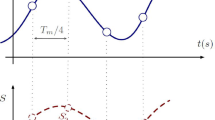Conclusion
Infrared imaging of thermal transients is very useful for the detection of honeycomb debonding. It is also useful for many other applications such as detection of cracks and thin spots in metal plates, or any other application where defects with different thermal properties create a temperature difference over the area of interest.
Similar content being viewed by others
References
Dereniak, E.L. and Crowe, D.G., Optical Radiation Detectors, John Wiley and Sons, New York, 39 (1984).
Dereniak, E.L. and Crowe, D.G., Optical Radiation Detectors, John Wiley and Sons, New York, 43 (1984).
Honeycomb samples were provided by the Tri-Industries division of UNC Aerospace of Terre Haute, IN.
Inframetrics, Inc., Model 600 IR Imaging Radiometer.
Dr. Scholl’s™ Foot Powder was used for this experiment.
Author information
Authors and Affiliations
Rights and permissions
About this article
Cite this article
Eliason, B.W., Western, A.B. Detection of metallic honeycomb disbonding by thermal imaging. Exp Tech 15, 36–38 (1991). https://doi.org/10.1111/j.1747-1567.1991.tb01161.x
Published:
Issue Date:
DOI: https://doi.org/10.1111/j.1747-1567.1991.tb01161.x




